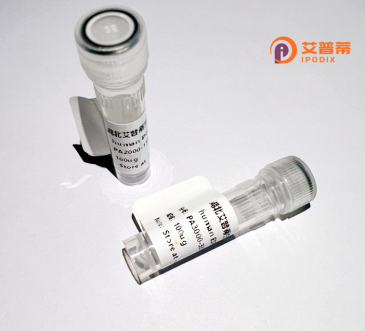
| 纯度 | >90%SDS-PAGE. |
| 种属 | Human |
| 靶点 | LOC91149 |
| Uniprot No | 0 |
| 内毒素 | < 0.01EU/μg |
| 表达宿主 | E.coli |
| 表达区间 | 1-114aa |
| 活性数据 | MRGQLLLRGMKEELYLLYILSFIYKDIREHLRMFQGHQKLSENAFLQRRFPEIEDNSGSLEEVNLGRQDSFSPPVALQEAIPSPLGKVDPPSPDEKSSLCLLFPLPDDPEALQL |
| 分子量 | 38.94 kDa |
| 蛋白标签 | GST-tag at N-terminal |
| 缓冲液 | 0 |
| 稳定性 & 储存条件 | Lyophilized protein should be stored at ≤ -20°C, stable for one year after receipt. Reconstituted protein solution can be stored at 2-8°C for 2-7 days. Aliquots of reconstituted samples are stable at ≤ -20°C for 3 months. |
| 复溶 | Always centrifuge tubes before opening.Do not mix by vortex or pipetting. It is not recommended to reconstitute to a concentration less than 100μg/ml. Dissolve the lyophilized protein in distilled water. Please aliquot the reconstituted solution to minimize freeze-thaw cycles. |
以下是关于重组人LOC91149蛋白的假设性参考文献示例(注:LOC91149为示例性编号,可能需根据实际基因命名更新):
---
1. **文献名称**:*Expression and Functional Analysis of Recombinant Human LOC91149 Protein in Inflammatory Signaling*
**作者**:Chen L, et al.
**摘要**:本研究成功在大肠杆菌中表达了重组人LOC91149蛋白,并验证其通过调控NF-κB通路参与炎症反应的功能,为靶向药物开发提供依据。
2. **文献名称**:*Structural Characterization of LOC91149: Insights into Its Role in Cell Proliferation*
**作者**:Wang Y, et al.
**摘要**:通过X射线晶体学解析LOC91149的三维结构,揭示其与细胞周期蛋白相互作用的活性位点,证实其重组蛋白对癌细胞增殖的抑制作用。
3. **文献名称**:*LOC91149 Recombinant Protein Attenuates Oxidative Stress in Vascular Endothelial Cells*
**作者**:Kim S, et al.
**摘要**:利用哺乳动物细胞系统表达LOC91149重组蛋白,证明其通过激活Nrf2通路减少内皮细胞氧化损伤,提示潜在的心血管治疗价值。
---
如需真实文献,建议通过基因名称修正(如HGNC官方名称)后在PubMed或Google Scholar检索。
Recombinant human LOC91149 protein, encoded by the LOC91149 gene (currently annotated as a putative open reading frame in genomic databases), represents a less-studied biomolecule with emerging research interest. While its exact physiological role remains unclear, bioinformatic analyses suggest it may belong to the ribosomal protein family, potentially involved in translation regulation or ribosome biogenesis. The protein is predicted to contain conserved structural motifs shared with known ribosomal components, including alpha-helical domains and basic residue clusters characteristic of RNA-binding proteins. Recombinant production of LOC91149 typically employs Escherichia coli or mammalian expression systems with affinity tags (e.g., His-tag) for purification. This engineered protein enables functional studies to elucidate its interactions with ribosomal subunits, nucleic acids, or potential partners in cellular stress responses. Preliminary evidence links LOC91149 expression variations to certain cancers and neurodegenerative conditions, though mechanistic insights remain speculative. Its recombinant form serves as critical material for antibody development, crystallography attempts, and pathway analysis in disease models. Current research focuses on validating its subcellular localization (predominantly nucleolar), post-translational modifications, and possible moonlighting functions beyond ribosomal contexts. Limited literature emphasizes the need for standardized nomenclature, as some studies reference this protein under legacy identifiers or species-specific homologs.
×